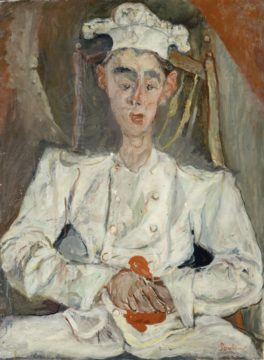Griffin Oleynick at Commonweal:
 It’s not hard to see what first drew Barnes and de Kooning to Soutine. His arresting portraits from the 1910s and ’20s, the first works on view, reveal both a wry distrust of himself and a sure confidence in his capacity to observe and render the inner lives of other people. In his laconic 1918 Self-Portrait, he’s clothed in a rumpled blue smock and stares straight ahead at the viewer; another portrait (evidently by Soutine) covers his right shoulder and fills the left side of the frame. Soutine is clearly channeling similar works by artists like Velázquez and Rembrandt, which he regularly studied in his frequent trips to the Louvre. Yet his own Self-Portrait, geometrically and chromatically centered on his puffy, blood-red lips, also evokes the grotesque—so called because it traditionally portrayed subjects best kept out of sight. After Barnes helped make him famous, Soutine began to appear at Parisian salons in elegant clothes (indeed, Polish writer and painter Józef Czapski calls attention to his “expensive felt hats and gleaming leather boots”), yet he remained something of an outsider.
It’s not hard to see what first drew Barnes and de Kooning to Soutine. His arresting portraits from the 1910s and ’20s, the first works on view, reveal both a wry distrust of himself and a sure confidence in his capacity to observe and render the inner lives of other people. In his laconic 1918 Self-Portrait, he’s clothed in a rumpled blue smock and stares straight ahead at the viewer; another portrait (evidently by Soutine) covers his right shoulder and fills the left side of the frame. Soutine is clearly channeling similar works by artists like Velázquez and Rembrandt, which he regularly studied in his frequent trips to the Louvre. Yet his own Self-Portrait, geometrically and chromatically centered on his puffy, blood-red lips, also evokes the grotesque—so called because it traditionally portrayed subjects best kept out of sight. After Barnes helped make him famous, Soutine began to appear at Parisian salons in elegant clothes (indeed, Polish writer and painter Józef Czapski calls attention to his “expensive felt hats and gleaming leather boots”), yet he remained something of an outsider.
more here.
